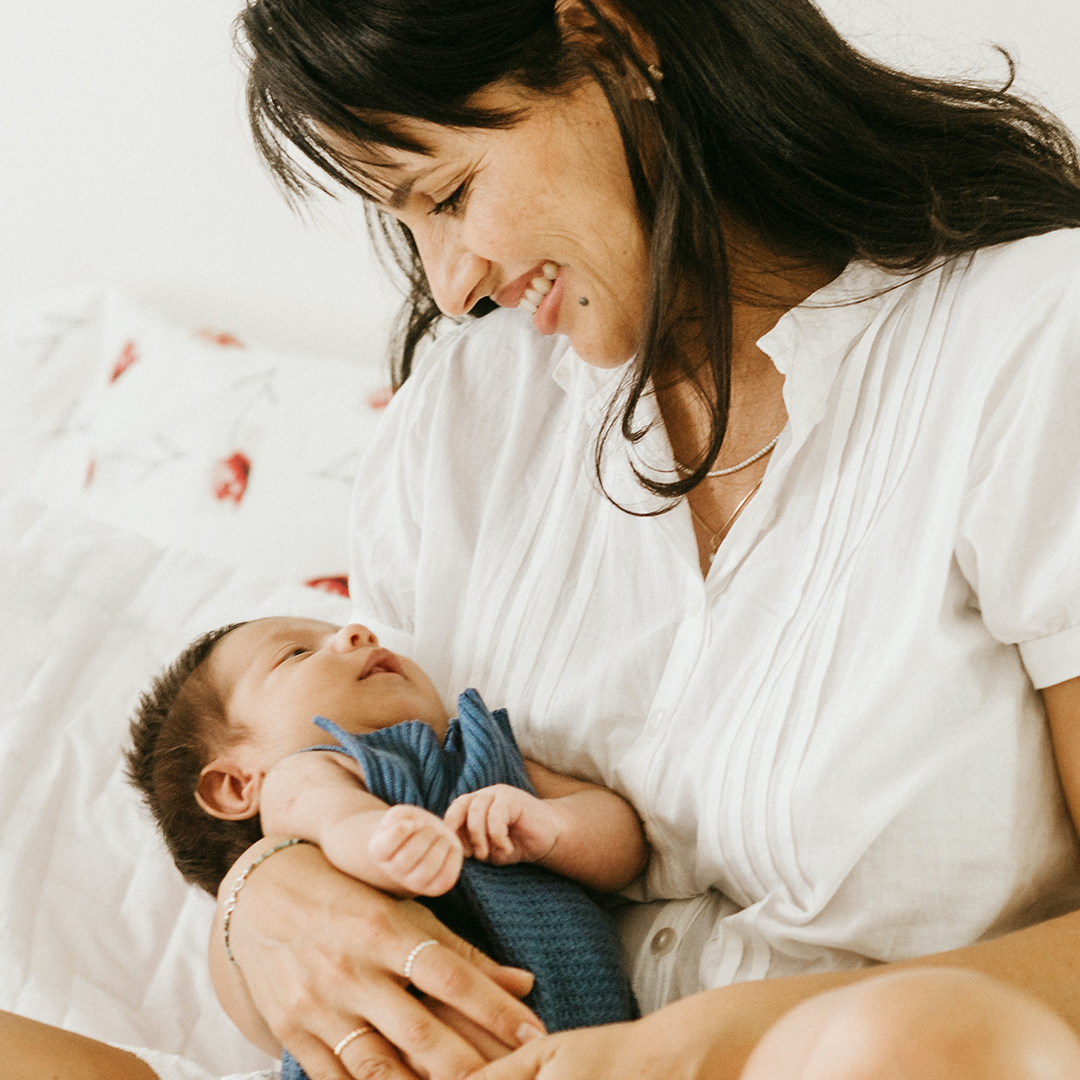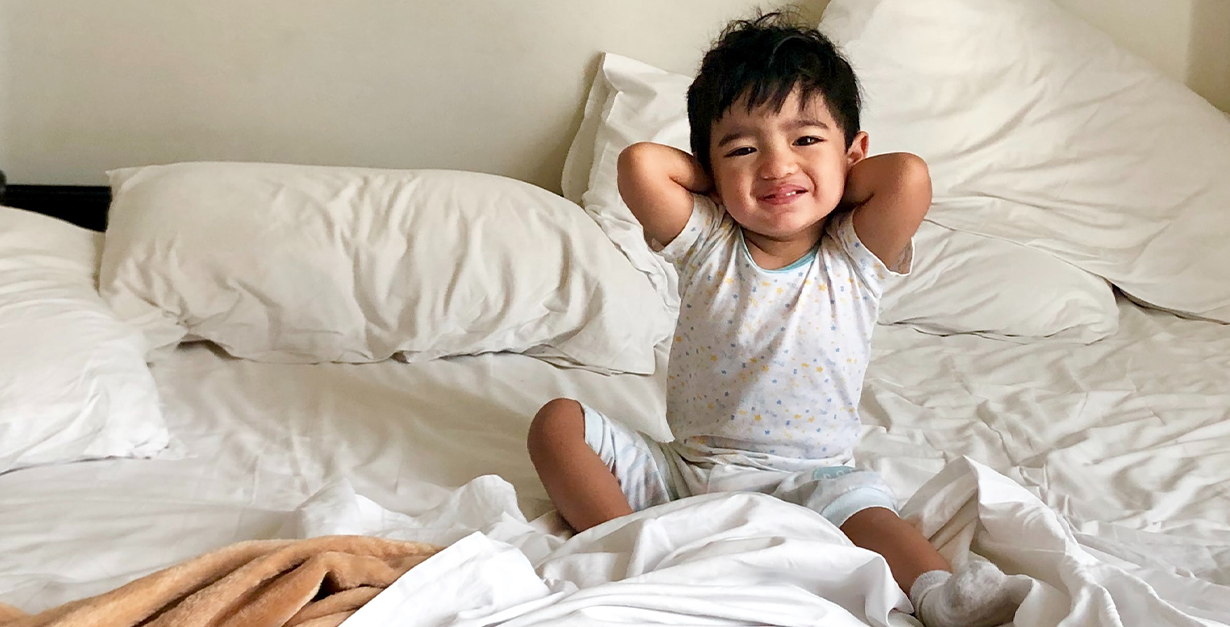Cosleeping Happens! What to Do About Accidental Bed-Sharing
Cosleeping Happens! What to Do About Accidental Bed-Sharing
There are lots of things to which we might say “not me” before having children. Maybe we think we will never leave the house without makeup on. Or maybe we used to look at the frustrated parents in line at the grocery store and we silently promised ourselves that we will be more prepared when we shop with a toddler. You might have thought, “I’ll never have a baby in MY bed.” Suddenly, though, you’re an exhausted parent, and cosleeping happens.
Nobody begins cosleeping with the intention of harming their child, but there are some safety issues associated with having a baby in bed. Learn about:
- Accidental cosleeping
- Why it can be great for you
- Room sharing as an alternative
- Safety rules to follow
Why Cosleeping Happens Accidentally
One of the most common things that new parents find themselves doing is accidentally co-sleeping with their baby. This article isn’t about those who consciously choose to cosleep, rather, it’s for those of you who have suddenly, perhaps reluctantly, ended up with your baby in your bed.
In a last ditch effort for everyone to get some sleep — because you’ve walked to the nursery or bassinet 10 times already tonight — your baby ends up in bed. It would be hard to find an honest parent who could say this hasn’t happened at least once or twice, even if for a few hours.
Accidental cosleeping happens when you are overtired and your bed just isn’t safe for your baby. Your only thought is that your baby will stop screaming when you hold him, and you need to sleep.
It is incredibly easy to accidentally cosleep. At some point in your child’s first year you will be bone tired and your baby will be struggling to get back to sleep. Often, the seemingly easiest route to peace and quiet is to bring your baby into your bed for a few hours, just so that you can rest. Most parents have done this at some point.
Some families who never intended to cosleep find themselves suddenly and habitually bed-sharing, and they want to stop. When you’re an “accidental co-sleeper”, or reactive co-sleeping, you may react to the current middle-of-the-night circumstances by bringing your child into your bed at some point.
Want to read more in-depth about cosleeping?
Read: Co-Sleeping and Room Sharing – Tips for Sleeping Safely
Co-Sleeping Is Not Taboo!
You may instinctively sense that this is one of those topics that people have strong opinions about, so you may not mention your middle-of-night habit to others.
Even those who make an informed and conscious choice to co-sleep may not feel comfortable talking about their choice openly. There is an unfortunate stigma associated with the choice to co-sleep, largely due to incidents that have resulted from parents who practice reactive co-sleeping.
Co-Sleeping Is A Great Option For Some Families
Cosleeping is often called “the family bed” and, while it may be controversial for some, it is a very popular approach to children’s sleep. Cosleeping can be done safely and in a way that supports your particular family’s needs. Eventually, children will need to learn how to put themselves to sleep but even this can be done in the family bed.
There’s more info out there about safe cosleeping:
Read: Safe Cosleeping: Creating a Safe Environment for your Baby
It’s Not Everyone’s First Choice
Cosleeping is not for everyone, though. Some families find that their children will not sleep when they’re in the same bed. Some parents have a different plan for how their family will function and choose to have a separate nursery ready for that first night home. This, too, is a great option and your family should decide what works best for you.
Room-Sharing Vs. Bed-Sharing
The American Academy of Pediatrics does not recommend bed-sharing, but does recommend room-sharing. Their latest advice to parents is to share a room, with the baby sleeping on their own, separate, safe surface for at least 6 months to one year. That means the baby has a bassinet, side-car, or crib in the same room with parents. It prevents accidental cosleeping because it is a short walk — or reach — to address nighttime wakings, so it’s more likely that parents will put their baby back to sleep in their safe environment.
Read more about the room-sharing recommendations:
Read: Room Sharing For The First Year: Is It Right For You?

Be Prepared if Cosleeping Happens for You
No matter what method you plan on doing, it is a good idea to learn how to safely co-sleep.
There is a good chance that you will want to reactively co-sleep at some point. It could even become an unplanned habit that lasts for 6 months! You can be prepared now for this possibility so that your baby is safe at all times.
If you sleepily bring your baby into your bed at night it is likely that you will not be bringing them to the safest environment for them to sleep. Your bedroom is not designed with your baby’s safety in mind. Babies, particularly those under 12 months, don’t need a fluffy blanket or duvet for a good night’s sleep! In fact, babies tend to wriggle and squirm down under the covers, which can block their airway. If they have trouble getting enough air to breathe they cannot push their covers off or may not even cry out for help.
What you can do is create a safe “makeshift” bed for those potentially desperate times: put a futon or extra mattress in your baby’s room — or on the floor near your bed — that has no pillows or duvets and is not a pillow top mattress. This can be your “crash pad” with your baby where you can safely rest when cosleeping happens in the middle of a hard night.
Safety First
We should not let others’ opinions shame us into silence about our well-thought-through parenting strategies. On the contrary, we should talk freely so that we can all learn from and support one another in our parenting.
One of the downsides of all this secret cosleeping is that the rest of us don’t talk about it enough and learn how to do it safely. We miss out on vital advice from healthcare workers if we do not talk openly about it. The dangers of suffocation, SIDS, and entrapment associated when spontaneous cosleeping happens are real and I want you to know how to avoid them at all costs.
Please talk to your physician about co-sleeping as well. There is no substitute for your medical doctor’s help and oversight of your child’s care.
Once you know the safe boundaries, you can sleep peacefully with your child nearby.
7 Dos and Don’ts of Bed Sharing
These guidelines (adapted from Dr. James McKenna’s Safe Cosleeping Guidelines) will help ensure your child’s safety if they end up in your bed at night. Think through how you can prepare now so that your baby will be safe if you happen to bring them into your room at night.
- Keep It Firm — Be sure your mattress is firm and the sheets are well-fitting. Never use a waterbed or any soft or flexible surface to sleep on.
- Move Away the Fluff — If you bring your child into your bed, then move away all pillows, blankets, and lovies. You may need to add a layer to your own pjs if they come into your bed!
- No Gaps — Use well-designed guardrails to protect your baby from rolling off the bed or becoming entrapped. Make sure there are no gaps between the mattress and the headboard or footboard. Some choose to move their mattress to the floor for a few months to reduce these risks.
- Bed Position — Ideally, move your bed away from walls for this period of time to avoid any entrapment should your baby sleep with you. It is hard to get a mattress close enough to a wall without creating an entrapment danger.
- Sleeping Position — Place your baby between a guardrail and the mother and not between the two parents. Mothers are characteristically more aware of their baby’s presence even when sleeping. Also, remember to place your baby on his back to sleep to reduce the risk of SIDS.
- Tell Your Partner — Every adult in the bed should be made aware that a baby is present in the bed each time it occurs. If the family bed is your ongoing choice then your partner will be aware of this from the outset. This is a warning for those of us who may accidentally co-sleep. It may feel counter-intuitive to wake your partner to let them know you are bringing your baby to bed to help everyone sleep better! But, this increases the safety for your child if everyone is aware of their presence with you.
- Your Hair — Put long hair back in an elastic band to avoid your child getting tangled in your hair which could pose a potential strangulation hazard. Sadly, this has happened before.
4 Situations When It is Best to Avoid Cosleeping
There a handful of situations when it is best to not bring your child into your bed at all because the risks to their health increase significantly under these circumstances.
- Deep Sleeper?— If mother tends to be a very deep sleeper (who will not awake to a baby’s cues) then you should avoid co-sleeping altogether.
- Smoking in the Bedroom — Secondhand smoke poses significant health risks to children.
- Body Awareness — If you are significantly overweight you may not be as aware of your body. Use a cosleeper attachment to your bed to ensure your baby’s safety.
- Mental Awareness — Never bring a child into your bed if you have been drinking alcohol or using any sort of drugs or medications that can impair your judgement. You may not be able to respond to your baby’s cues.
When it comes to co-sleeping, we are passionate about finding a solution that feels right for you.
We’re the only online sleep training course that addresses co-sleeping - whether you want to end it or safely continue. Register for Gentle Sleep Solutions today to start getting the sleep your family needs!
Sometimes cosleeping happens to even the parents with no intention of having their baby in bed. Consider these guidelines so that you can keep your baby safe at all times!
The post Cosleeping Happens! What to Do About Accidental Bed-Sharing appeared first on The Sleep Lady.
https://ift.tt/3oQCSEA from The Sleep Lady https://ift.tt/39DKzYm



Post a Comment